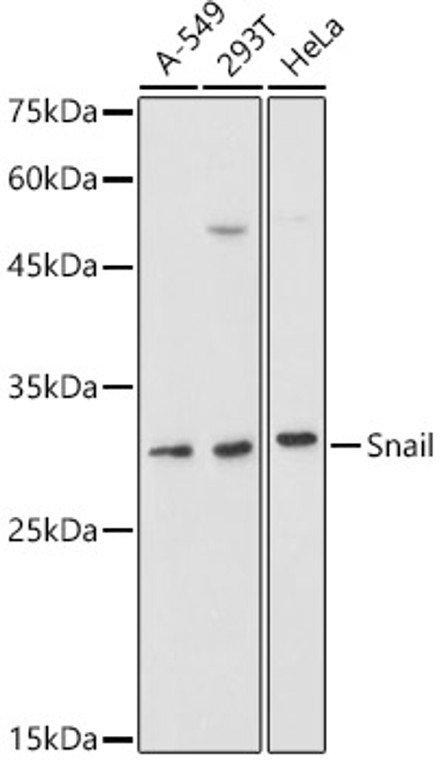| Host: |
Rabbit |
| Applications: |
WB/IHC/IF |
| Reactivity: |
Human/Mouse/Rat |
| Note: |
STRICTLY FOR FURTHER SCIENTIFIC RESEARCH USE ONLY (RUO). MUST NOT TO BE USED IN DIAGNOSTIC OR THERAPEUTIC APPLICATIONS. |
| Short Description: |
Rabbit polyclonal antibody anti-Snail (200-267) is suitable for use in Western Blot, Immunohistochemistry and Immunofluorescence research applications. |
| Clonality: |
Polyclonal |
| Conjugation: |
Unconjugated |
| Isotype: |
IgG |
| Formulation: |
PBS with 0.01% Thimerosal, 50% Glycerol, pH7.3. |
| Purification: |
Affinity purification |
| Dilution Range: |
WB 1:500-1:1000IHC-P 1:50-1:200IF/ICC 1:50-1:200 |
| Storage Instruction: |
Store at-20°C for up to 1 year from the date of receipt, and avoid repeat freeze-thaw cycles. |
| Gene Symbol: |
SNAI1 |
| Gene ID: |
6615 |
| Uniprot ID: |
SNAI1_HUMAN |
| Immunogen Region: |
200-267 |
| Immunogen: |
A synthetic peptide corresponding to a sequence within amino acids 200-267 of human SNAI1 (NP_005976.2). |
| Immunogen Sequence: |
RTHTGEKPFSCPHCSRAFAD RSNLRAHLQTHSDVKKYQCQ ACARTFSRMSLLHKHQESGC SGCPR |
| Tissue Specificity | Expressed in a variety of tissues with the highest expression in kidney. Expressed in mesenchymal and epithelial cell lines. |
| Post Translational Modifications | Phosphorylated by GSK3B. Once phosphorylated, it becomes a target for BTRC ubiquitination. Phosphorylation by CSNK1E, probably at Ser-104, provides the priming site for the subsequent phosphorylation by GSK3B, probably at Ser-100 and Ser-96. Phosphorylation by PAK1 may modulate its transcriptional activity by promoting increased accumulation in the nucleus. Phosphorylation at Ser-11 and Ser-92 positively regulates its functions in induction of EMT and cell survival, respectively. Phosphorylation by LATS2, upon mitotic stress, oncogenic stress or Hippo pathway activation, occurs in the nucleus and promotes nuclear retention and stabilization of total cellular protein level. Ubiquitinated on Lys-98, Lys-137 and Lys-146 by FBXL14 and BTRC leading to degradation. BTRC-triggered ubiquitination requires previous GSK3B-mediated SNAI1 phosphorylation. Ubiquitination induced upon interaction with NOTCH1 or TP53/p53 is mediated by MDM2. Ubiquitinated in a FBXL5-dependent manner.preventing interaction with DNA and promoting its degradation. Deubiquitinated by USP37.leading to stabilization. O-GlcNAcylation at Ser-112 is enhanced in hyperglycaemic conditions, it opposes phosphorylation by GSK3B, and stabilizes the protein. ADP-ribosylation by PARP1 increases protein half-life and may be involved in TGFB-induced SNAI1 up-regulation. |
| Function | Involved in induction of the epithelial to mesenchymal transition (EMT), formation and maintenance of embryonic mesoderm, growth arrest, survival and cell migration. Binds to 3 E-boxes of the E-cadherin/CDH1 gene promoter and to the promoters of CLDN7 and KRT8 and, in association with histone demethylase KDM1A which it recruits to the promoters, causes a decrease in dimethylated H3K4 levels and represses transcription. The N-terminal SNAG domain competes with histone H3 for the same binding site on the histone demethylase complex formed by KDM1A and RCOR1, and thereby inhibits demethylation of histone H3 at 'Lys-4' (in vitro). During EMT, involved with LOXL2 in negatively regulating pericentromeric heterochromatin transcription. SNAI1 recruits LOXL2 to pericentromeric regions to oxidize histone H3 and repress transcription which leads to release of heterochromatin component CBX5/HP1A, enabling chromatin reorganization and acquisition of mesenchymal traits. Associates with EGR1 and SP1 to mediate tetradecanoyl phorbol acetate (TPA)-induced up-regulation of CDKN2B, possibly by binding to the CDKN2B promoter region 5'-TCACA-3. In addition, may also activate the CDKN2B promoter by itself. |
| Protein Name | Zinc Finger Protein Snai1Protein Snail Homolog 1Protein Sna |
| Database Links | Reactome: R-HSA-8943724Reactome: R-HSA-9758919Reactome: R-HSA-9762293 |
| Cellular Localisation | NucleusCytoplasmOnce Phosphorylated (Probably On Ser-107Ser-111Ser-115 And Ser-119) It Is Exported From The Nucleus To The Cytoplasm Where Subsequent Phosphorylation Of The Destruction Motif And Ubiquitination Involving Btrc Occurs |
| Alternative Antibody Names | Anti-Zinc Finger Protein Snai1 antibodyAnti-Protein Snail Homolog 1 antibodyAnti-Protein Sna antibodyAnti-SNAI1 antibodyAnti-SNAH antibody |
Information sourced from Uniprot.org
12 months for antibodies. 6 months for ELISA Kits. Please see website T&Cs for further guidance













